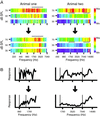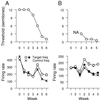Neural correlates of instrumental learning in primary auditory cortex
- PMID: 12119383
- PMCID: PMC126633
- DOI: 10.1073/pnas.092278099
Neural correlates of instrumental learning in primary auditory cortex
Abstract
In instrumental learning, Thorndike's law of effect states that stimulus-response relations are strengthened if they occur prior to positive reinforcement and weakened if they occur prior to negative reinforcement. In this study, we demonstrate that neural correlates of Thorndike's law may be observed in the primary auditory cortex, A1. Adult owl monkeys learned to discriminate tones higher than a standard frequency. Responses recorded from implanted microelectrodes initially exhibited broad spectral selectivity over a four-to-five octave range. With training, frequency discrimination thresholds changed from close to one octave to about 1/12 octave. Physiological recordings during the week in which the monkey came under behavioral control signaled by a drop in measured threshold had stronger responses to all frequencies. During the same week, A1 neural responses to target stimuli increased relative to standard and nontarget stimuli. This emergent difference in responsiveness persisted throughout the subsequent weeks of behavioral training. These data suggest that behavioral responses to stimuli modulate responsiveness in primary cortical areas.
Figures




References
-
- Domjan M. The Principles of Learning and Behavior. 4th Ed. Belmont, CA: Wadsworth; 1997.
-
- deCharms R C, Blake D T, Merzenich M M. J Neurosci Methods. 1999;93:27–35. - PubMed
-
- Jenkins W M, Merzenich M M, Ochs M T, Allard T, Guic-Robles E. J Neurophysiol. 1990;63:82–104. - PubMed
-
- Recanzone G H, Merzenich M M, Jenkins W M, Grajski K A, Dinse H R. J Neurophysiol. 1992;67:1031–1056. - PubMed
-
- Recanzone G H, Merzenich M M, Schreiner C E. J Neurophysiol. 1992;67:1071–1091. - PubMed
Publication types
MeSH terms
Grants and funding
LinkOut - more resources
Full Text Sources

